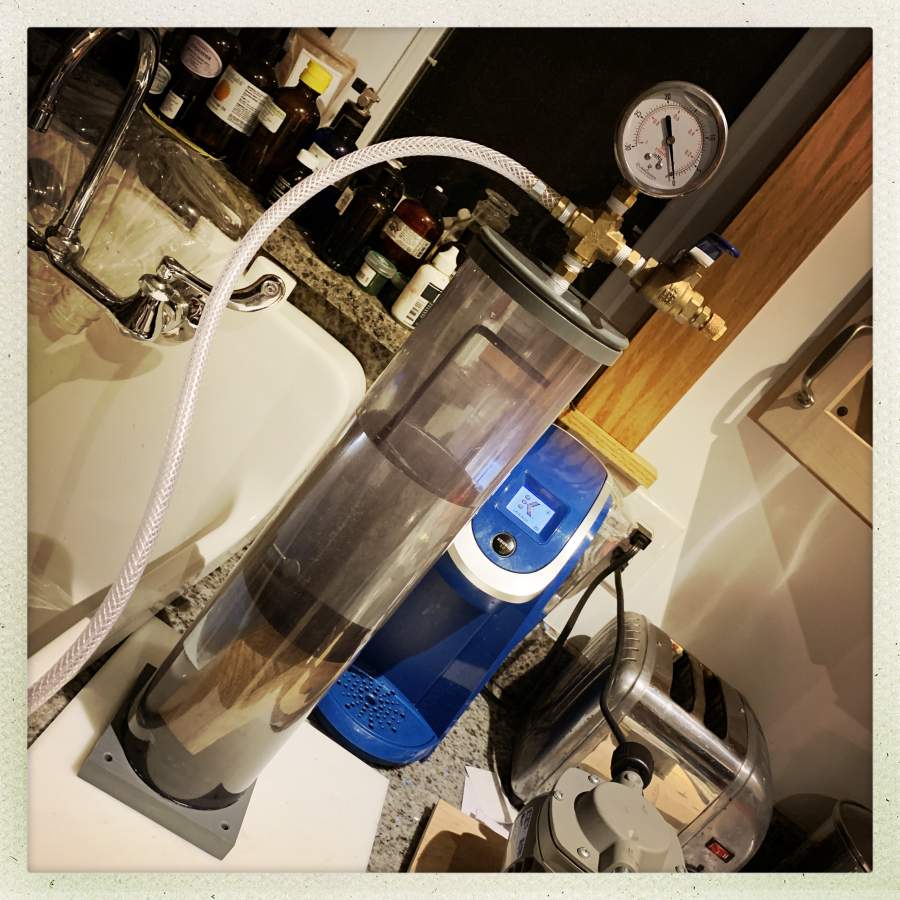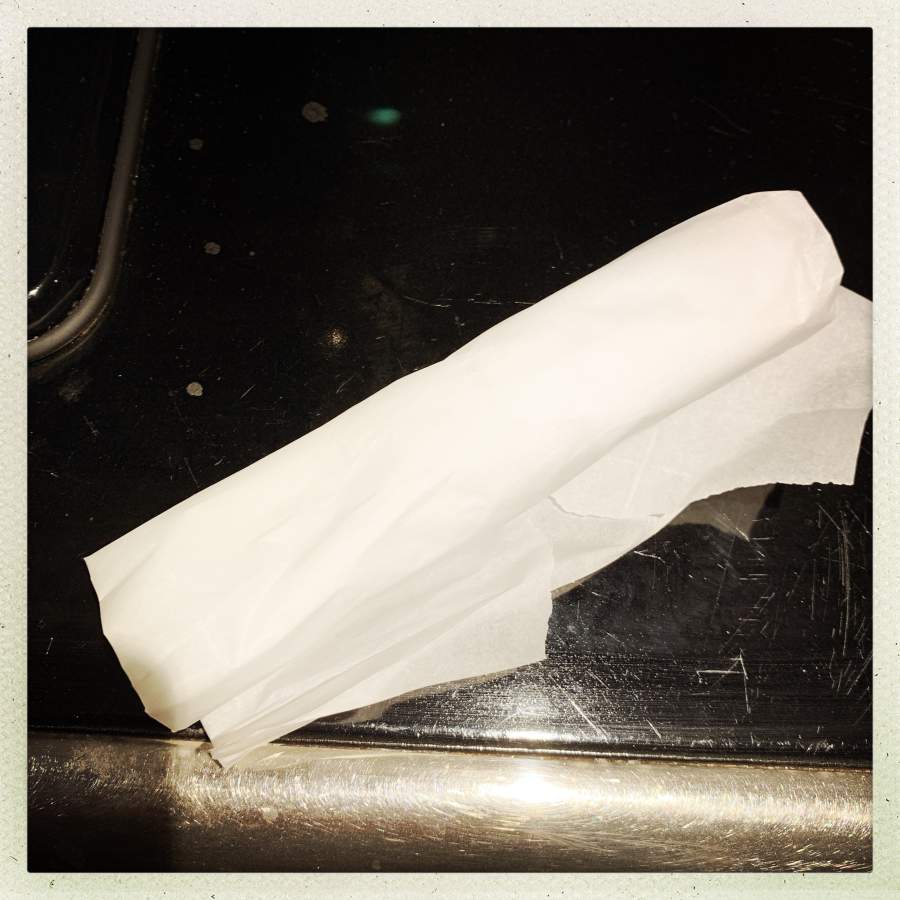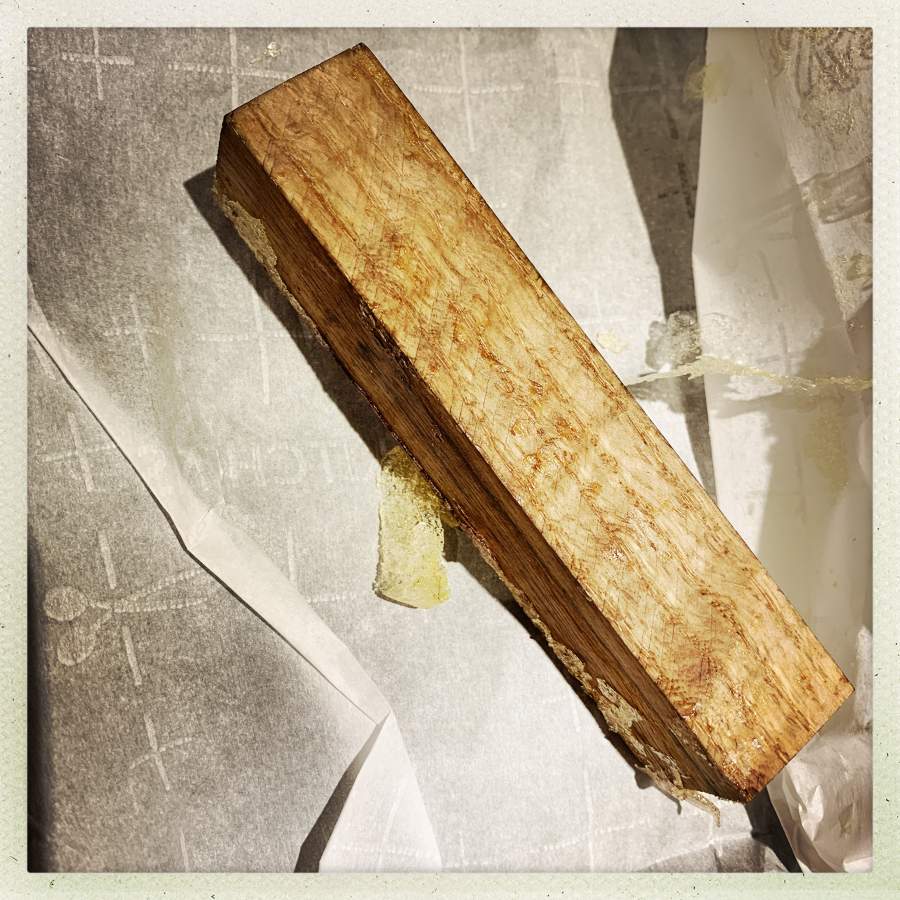Resin infusing wood (“stabilizing”) is all the rage in some parts of the knife-maker community. I used to impregnate all my handles with linseed oil and slowly dry them – same effect, just a different polymer.
Here’s how it’s done: basically, you need something to hold the wood under the resin, a container, and a vacuum pump. I have a vacuum chamber that I made for degassing my silicone molds (turns out they generally don’t need it!) consisting of a lucite panel and a silicone gasket, that goes atop a 2 gallon stainless steel pasta cooker. The panel is drilled with a T, and a ball valve (to release the vacuum) and a hose with a quick connect to the vacuum pump.
Initially that was how I did my resin infusion but I got resin all over the place because the container I was using inside the cooker was silicone and would flop around. Mike P. got one of of the Conestoga systems, which I had been, seriously, thinking of building myself, but given that the Conestoga system cost about $10 more than the parts, I got lazy.

The upper lid is routed in a circle and poured with silicone to make a gasket. Very nice! There’s a sort of dipper-thing which is also convenient as heck: you can lift the wood and let it drain by clipping it with a clamp across the upper rod. The lower and upper parts are heavy steel, which prevent the wood from floating up. You put your wood between the steel parts, adjust the set-screw, and lower the whole mass into the cylinder. Then, you pour the resin in, pop the lid on, and evacuate the tube.
Cactus Juice is the commercial name of the resin I use; it’s popular and is compatible with most alumilite dyes. So some knife-makers infuse UV colors into perfectly good wood, or add a ton of black for that Tactical(tm) appearance. I admit that I have 2 gallons of cactus juice resin – one clear, one blue/black. The blue puts lovely hints into bog oak, and the resin really strengthens some otherwise crumbly wood. You can resin infuse spalted wood, as I have on some of my knives, and it makes it solid enough to use for knife handles.
I usually do several cycles of bringing up the vacuum, letting it sit (there is a slow leak) and infuse, then bringing the vacuum back up again. After a while the wood will hardly bubble at all. That’s when it’s done.
Here’s what it looks like:
I’m not a material scientist but my understanding of how most epoxies work is that they are thermal cure, and the “hardener” is a catalyst that warms the epoxy up, cooking it to a cure which makes it harden and expand slightly. The Cactus Juice appears to be a resin with thinner and no hardener – it’s like thick water, odorless and cleans up with soap – but you can cook it and it gets hard. Once I’ve infused it, I wrap it in parchment paper so it won’t weep resin and stick to something in my oven, and leave it to cook for 2-3 hours at 220F.
 Other knife-makers use aluminum foil, which sticks like mad to the resin; I keep telling them to try parchment paper. I get a lot of “thank you” emails.
Other knife-makers use aluminum foil, which sticks like mad to the resin; I keep telling them to try parchment paper. I get a lot of “thank you” emails.
After 3 hours it looks like this:

You can see where the resin foamed out and hardened. That would have glued the wood pretty thoroughly to anything that is not seriously non-stick. The resin sands and shapes as though it’s not there and gives the wood a bit of extra gloss when you finish and polish it. What’s really nice is that it does not completely seal the wood, so normal finishes like wax and oil will penetrate a little way in and you can’t tell the wood is sealed inside.
The people who make Cactus Juice are smart – they put some mild scent in the resin, so you can tell it’s cooking but it’s not too nauseating.

This technique is inexpensive and valuable. I may use it for other wood projects and possibly even leather. In my wood shop area, I have a wood lathe that I have been meaning to set up, so I can do some composite wood/resin bowls and stuff like that. I’ve just been too busy with the metal-work (though the lathe would help for doing handles!) I may try doing some spalted wood bowls – basically, rotten wood – after resin infusing them. I wonder if they’ll survive turning? I’ll wear a leather coat and my face helmet if I try that.
I’ve got the vacuum pump on a separate base with a power switch and suction feet. That makes it incredibly quiet for a vacuum pump. I used to use this unit to vacuum filter my silver nitrate for wet plate photography. Having it rigged with a quick release is very useful.

Does it make the wood look like it’s oiled or finished in some way, or was that piece of wood like that to start with? It looks great. What a neat technique.
I’m intrigued on how this would work with leather. I would assume it would stiffen it though. Spalted wooden bowls would be gorgeous.
thanks for posting this, I was wondering how it cured, and I sorta assumed they used a low-viscosity mix with a long cure time, and then saturated the wood with it. Using something that heat cures makes more sense.
There are a couple sellers on ebay that sell vacuum chambers (the spaghetti cooker design) for pretty cheap, if anyone wants to get into this. The vacuum pump is the expensive part ($200 for a decent one) I have a venturi vacuum generator I am looking forward to experimenting with (around $50) but it requires an air compressor to operate.
The hardware setup for a basic vacuum chamber is simple; you can see how it’s set up in the video.
Once the wood has been soaked and baked it takes a shine from fine sanding and buffing. It’s a pretty cool process.
Marcus,
I’m not a material scientist but my understanding of how most epoxies work is that they are thermal cure, and the “hardener” is a catalyst that warms the epoxy up, cooking it to a cure which makes it harden and expand slightly.
That’s not how epoxies work. The reaction is exothermic, but that’s a side effect. Simply heating the resin of a two-part epoxy, without the hardener, would not cure it.*
The hardener reacts with the epoxy and links the molecules together in one big, tangled mass. The hardener molecules are small, but have several “attachment points” each, so they tie several of the long, squiggly resin molecules together. This stops them from sliding against each other. Many hardeners react very slowly at room temperature, though, so, once mixed, the adhesive needs to be heated to cure. Some hardeners react so slowly that they are sold mixed with the epoxide, as a “one component” system, and still have a semi-decent shelf life if kept cool.
For home users, though, they use a hardener that reacts quickly at room temperature. The result is not quite as good (and the hardener smells), but it’s much more practical for DIY.
The faster the epoxy hardens, the hotter it gets. All systems have roughly the same amount of energy to release while they cure, the difference is whether you get it all back in a few of minutes, or over the course of a few hours. The hotter the mixture is, the faster it reacts, too, so if you mix a largish batch of fast epoxy, things can get interesting.
* Actually, it might cure if you really heat it, but it’d be very different from a properly cured resin.
(googles spalted wood)
(drools)
Badland:
Look for turned spalted wood bowls.
The wood is semi decomposed – the black lines are fungus. It is significantly weakened. Also, if a woodworker breathes the fungus dust they may wind up with fun stuff growing in their lungs. So resin helps kill the residents in the wood as well as hardening it.
A lot of lathe-workers steer away from spalted wood after the first time it explodes in their face.
I’ve always been sceptical that it still feels like wood?
My handles have mostly been made from decent condition eucalyptus, so they’re tough to start off with and it seemed unnecessary
@dangerousbeans, I have no personal experience, but from what I read and what I can surmise as a (former) dendrologist, not all woods are suitable for this. Heartwood of oak and black locust are allegedly difficult and impossible in larger pieces, beacause he heartwood has pores filled with lilgnin and other chemicals (that is why it has different colour). This makes it a lott less willing to accept fluids than the heartwood – and also more resistant to rot etc. Oily woods like osage orange, cocobollo would be probably impossible to treat this way, and extremely high-desity woods like ebony or boxwood would be difficult. Low to middle density woods, or as Marcus writes, partly decomposed woods, are best suited for this technique. Local knifemakers use it to sabilize basswood, birch and willow burls, for example.
@lochaber, where I live, the Cactus Juice cannot be readily bought, so local knifemakers are using what you have surmised – low density, slow curing resins.
I inted to use this technique too, it is definitvely on my “to do” list as soon as I have time. Which won’t be anytime soon, unfortunately :-(.
dang it. Replace ” his makes it a lott less willing to accept fluids than the heartwood” with “This makes it a lot less willing to accept fluids than the sapwood”.
dangerousbeans@7
I don’t have near the experience that a lot on these boards have, but I’ve handled a handful of knives with stabilized wood handles, and I’d say they are more like plastic? I think it’s more about the surface finish, whether it’s got a super-fine polish, or if it was finished in a bit rougher manner. But then, I think the grip maybe matters less about the actual material, then it is about the shaping and texturing of it.
I may be way off here, but I feel like one of the main purposes of resin-stabilizing wood is to preserve the natural wood aesthetic, whilst imbuing it with an increased resistance to wear and water.
There are a lot of natural processes that, while common, are really hard to artificially replicate, and lead to efforts to preserve, modify, and adapt them.
Charly@8
cool, thanks for the validation (or whatever…) completely off-tangent, but for a brief period, I was wondering about how to get whatever resin to more deeply penetrate lumber/plywood for use in aquariums/vivariums/paludariums…
As far as the “feel ” goes, I have no experience with resin stabilized wood yet either, but to my mind no treated wood “feels” like wood anymore, be it treated with oil, wax, parrafine or lacuqer.
So far from purely tactile point of view I personaly prefer linseed oil and beeswax – these finishes feel warm and ever so sligthly tacky in the hand, which allows for really firm grip. But they are not as durable as PU coating or this, especially the wax, and they get dirty real quick, again, especially the wax
I suspect the whole process is an idea someone got from making micarta, which is a resin-infused layup like plywood. Micarta is definitely plastic-y. Stabilized wood feels pretty natural, it’s just a bit heavier.
Initially I was worried that it might stick to a table-saw blade, but it’s fine.
If anyone wants a sample chunk, I have lots, including some lovely spalted maple. Just tell me what size you want and where to send it.
I bought my SiL a spalted ash bowl, it feels like it’s been polished, but not highly polished, very very slightly soft to the touch. It looks and feels lovely, and has lasted for around twenty years at this point. The burl bowls I have are not resin impregnated and need oiling from time to time.
Jazzlet@#13:
Spalted ash sounds lovely!
I have some really nice spalted pieces on my bench, ready for blades to go in ’em.
@Charly thanks! it seems a lot of the woods i’m using are harder to find outside Australia so it’s hard to find information on them. most of them are pretty close to ebony in density, so i’ll treat them like that.
@Marcus Ranum I’ll happily take a sample chunk, something that’s a good size for a wa handle would be nice. I can send you some bits in exchange: i have some jarrah and ironbark, and i’m going to go poke around the recycled timber place this weekend and see if they have any interesting off-cuts.
i’m liking jarrah at the moment: https://imgur.com/gallery/aLobpkD
Marcus @#14
It is beautiful, I stroke it when I visit.
I am fond of ash, we had a friend who is a cabinet maker make our kitchen and she made the cupboard doors out of ash. It looks fantastic, and even after seeing it day in and day out for over fifteen years I still see the beauty of the wood.
Jazzlet@#16:
I believe I have a nice piece of ash for you. I shall have to consult mister happy dancing bandsaw.
dangerousbeans@#15:
@Marcus Ranum I’ll happily take a sample chunk, something that’s a good size for a wa handle would be nice.
Excellent. I actually have some that’s just the right size, all cooked and ready to go. I will email you for an address. If you don’t hear from me by ${right now} check your spam box.
All this discussion of wood is making me think I really really need to set up my lathe again. It’s been sitting around without a drive belt and the motor mount needs to be looked at. That’s a sad state of affairs.
I’ve been curious about this since receiving Jack’s hacksaw brush. I’d been picturing it quite differently.